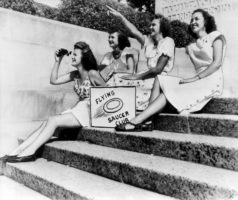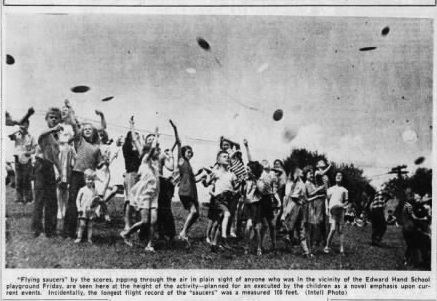By Charles Lear
 The very first flying saucer flap occurred during the summer of 1947. It began with the reported sighting of nine mysterious objects by pilot Kenneth Arnold on June 24 and hit its peak that July. This was the first, “summer of the saucers.” Much has been written about Arnold’s sighting but the sightings after that have been largely ignored. For the interested student of this period in U.F.O. history, there is a document available online that is well-worth reading. It provides a comprehensive account of the flap, citing a large number of newspaper articles that appeared during that time.
The very first flying saucer flap occurred during the summer of 1947. It began with the reported sighting of nine mysterious objects by pilot Kenneth Arnold on June 24 and hit its peak that July. This was the first, “summer of the saucers.” Much has been written about Arnold’s sighting but the sightings after that have been largely ignored. For the interested student of this period in U.F.O. history, there is a document available online that is well-worth reading. It provides a comprehensive account of the flap, citing a large number of newspaper articles that appeared during that time.
Housed at the University of Iowa is a thesis paper written in 1948 titled, “The ‘Flying Saucers’ Episode.” It was submitted by State University of Iowa journalism graduate student, Emil Earl Wennergren, as part of the requirements for his Master of Arts Degree. It is also available on the National Investigation Committee on Aerial Phenomena website. Besides providing insight into the fervor of the time and the effect it had on Arnold, there is an early look at the events at Roswell. Most amusing is the conclusion by Wennergren that Roswell marked the end of what was just a passing fascination.
In the introduction, Wennergren notes that many articles refer to “disks” and “discs.” The reader is informed that, according to Webster’s International Dictionary, “disk” refers to an inanimate object, whereas “disc” is the preferred spelling in zoology and botany. He then describes Arnold’s sighting of “nine shiny objects” near Mt. Rainier in Washington State. Arnold told reporters that they flew with a motion “like a fish flipping in the sun.” The story was on page 1 of the June 26, edition of the Portland Oregonian and spread to papers throughout the United States that same day.
Not in the thesis paper is the origin story for the term, “flying saucers.” When Arnold spoke with reporters, he described that the craft flew erratically, “like a saucer if you skip it across water.” In the June 26, 1947 East Oregonian de Pendelton, reporter Bill Bequette wrote that Arnold had “described the objects as ‘saucer-like.'” The story went out on the news wires and other papers reported that Arnold had seen “saucer-like” objects. The Chicago Sun picked up the story and their headline for it that same day was, “Supersonic Flying Saucers Sighted by Idaho Pilot.” From then on, people all over the country began seeing “flying saucers.”
As of June 26, Arnold was famous and his name was forever linked in history with flying saucers. Soon people were seeing them everywhere and they became a media sensation. Papers that carried saucer stories, more often than not, printed them on page 1 into the first half of July. While Arnold was genuinely puzzled and interested in getting some answers as to what the objects might have been, Wennergren noted that the media treated the saucers as a novelty. According to him, the subject “tickled the funny bones in the same manner as the bow ties and sockwear (sic) worn by the bobby-sox multitudes.”
Arnold was besieged by both the media and the public. His woes are described in an article in the June 28, Portland Oregonian. He told the paper that a preacher from Texas had called him. The preacher told him that the saucers marked the beginning of “doomsday” and he was “getting his flock ‘ready for the end of the world.'” Arnold also said that when he was in a Pendleton cafe on June 26, a woman came in, recognized him and ran out “shrieking, ‘There’s the man that saw the men from Mars!'” He summed up what he perceived was the public’s opinion of him: “Half the people look at me as a combination Einstein, Flash Gordon and screwball.”
Fortunately for Arnold, a man came forward with a report that supported his sighting. The June 26, Denver Post reported that another pilot, Bryon Savage, of Oklahoma City, Oklahoma, reported seeing a “flat, disklike (sic) object come across the city from the southeast.” He claimed to have seen it weeks before Arnold’s sighting made the papers. According to him, it had a “shiny, silvery color”, was “very big and was moving at a terrific rate of speed.” He noted that it “didn’t make any noise”, which would be a common description among witnesses well beyond 1947.
Another report quickly followed. The June 27, Chicago Tribune carried the description of a Kansas City, Kansas man. He reported seeing nine objects “with one a little one off to one side.” Skeptics immediately weighed in and accused both men of making up their stories based on what Arnold had reported. Savage countered by saying he had been afraid of ridicule and that Arnold’s sighting had encouraged him to come forward. Others reported that they had seen saucers before Arnold. They too said that they had only come forward because of Arnold.
An unfortunate aspect of Arnold’s sighting report was that he was the sole witness. Because he appeared to be a particularly credible witness, his story was considered newsworthy. That set a precedent for editors to accept other single witness testimonies. Story after story appeared with a single witness, often with an emphasis on their credibility as the sole support.
 Multiple witness reports eventually started being reported. The June 28, Denver Post reported that seven witnesses who worked for the Manitou and Pike’s Peak railroad said they’d seen objects similar to what Arnold had seen. The June 29, Portland Oregonian carried the story of a group of friends in San Francisco. They said they heard “swishing, whistling sounds over the bay” and then saw objects “30 to 50 feet across” flying in a northerly direction. The July 1, edition of the same paper told of a high school student and two nuns who claimed they had seen nine “discs” flying over La Grande, Oregon.
Multiple witness reports eventually started being reported. The June 28, Denver Post reported that seven witnesses who worked for the Manitou and Pike’s Peak railroad said they’d seen objects similar to what Arnold had seen. The June 29, Portland Oregonian carried the story of a group of friends in San Francisco. They said they heard “swishing, whistling sounds over the bay” and then saw objects “30 to 50 feet across” flying in a northerly direction. The July 1, edition of the same paper told of a high school student and two nuns who claimed they had seen nine “discs” flying over La Grande, Oregon.
Wennergren noted that, for the first three days in July, flying saucer stories were absent from most of the larger dailies throughout the country except for those in the Pacific Northwest. Then, July 4, brought a “deluge” of reports that made the national news. In the July 5, Portland Oregonian there was a story that involved multiple, highly credible witnesses. Portland Police had been put on an “all car” alert after three patrolmen, two in one car and one in another, reported seeing objects. One of them described the objects as “aluminum or egg-shell white discs that did not flash.” Many other officers were listed as having seen discs that night. The July 6, edition carried an Associated Press story of 200 witnesses in Idaho who’d reportedly seen a disc over Hauser Lake. The July 5, Minneapolis Star reported that, in the city of Twin Falls, Idaho, sixty picnickers observed “several echelons of ‘discs’ in the afternoon.”
A July 4, sighting reported by a captain, co-pilot and stewardess aboard a United Airlines DC-3, received major attention and was not easily refuted by skeptics. Captain Emil J. Smith, himself a skeptic, was alerted when his co-pilot, Ralph Stevens, blinked the landing lights. Smith asked him why he was doing so and Stevens replied, “There’s a plane approaching our bow.” Smith described the events in a letter written for the International News Service. He wrote that he and Stevens quickly saw that the object was not a plane, but “a flying disc.” They then saw four more and, though they couldn’t determine their “exact shape” they noted that they were larger than the DC-3, “fairly flat, smooth on the bottom and rough on top.” Smith called the stewardess, Marty Morrows to the cockpit and she confirmed their sighting.
Arnold would soon befriend Smith and Smith would accompany him on his investigation of “The Maury Island Incident.” Arnold wrote about his sighting, Smith’s sighting and their investigation together in two articles for the Jan. 1948 premier issue of Fate magazine. He later recounted the events in the first five chapters of the 1952 book “The Coming of the Saucers”, co-written with Fate publisher and editor, Ray Palmer.
According to Wennergren, the “flying saucers lived a short, full life.” After “the incident at Roswell Field” saucer stories appeared less frequently in newspapers. Finally, “an unaccountable phenomenon was retired to the newspaper Valhalla – the morgue.”
The “incident at Roswell field” refers to the July 8, press release from Roswell Airfield that they were “fortunate enough to gain possession of a disk through the cooperation of one of the local ranchers…” The statement was released by the public information officer, Lt. Walter Haut. The story was front page and the world eagerly awaited the answer to the flying saucer mystery. The answer came from Maj. Gen. Roger Ramey that evening in a radio broadcast from Fort Worth, where the “disk” had been examined. Newspapers reported the story the following day with “conspicuously small” headlines. According to Ramey, the Air Force had recovered a weather balloon.
Wennergren closed chapter IV of his thesis with the following:
“Thereafter, if the saucers flew, they flew in silence, because the nation’s press was through with them. Their appeal had burst in some vague manner after their dramatic appearance in New Mexico. Their swan song was a short one and faded quickly.”
Whew! Glad the hullabaloo over that particular mystery ended so quickly or we might still be talking about it.